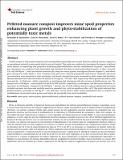| dc.contributor.author | Indraratne, Srimathie P. | |
| dc.contributor.author | Pierzynski, Gary M. | |
| dc.contributor.author | Baker, Lucas R. | |
| dc.contributor.author | Prasad, P.V. Vara | |
| dc.contributor.author | Arachchige, Pavithra S. Pitumpe | |
| dc.date.accessioned | 2023-02-14T19:30:29Z | |
| dc.date.available | 2023-02-14T19:30:29Z | |
| dc.date.issued | 2022-08-18 | |
| dc.identifier.citation | Indraratne, Srimathie P., Gary M. Pierzynski, Lucas R. Baker, P.V. Vara Prasad, and Pavithra S. Pitumpe Arachchige. “Pelleted manure compost improves mine spoil properties enhancing plant growth and phyto-stabilization of potentially toxic metals.” Canadian Journal of Soil Science 102 (2022): 719–731. DOI: dx.doi.org/10.1139/CJSS-2021-0157. | en_US |
| dc.identifier.issn | 0008-4271 | |
| dc.identifier.uri | https://hdl.handle.net/10680/2036 | |
| dc.description.abstract | Feedlotmanure is rich in plant nutrients and can immobilize potentially toxic metals. However, pelleted manure compost as an amendment material in mine spoils (chat) is not well studied. This study was conducted to investigate the impact of pelleted cattle manure on improving chat properties facilitating phyto-stabilization and the establishment of grasses. A greenhouse pot experiment was conducted with unamended and amended chat (lime treated) with pelleted manure at three rates (60, 120, and 180 Mg ha−1) with and without bentonite (B), using two native grasses, switchgrass (Panicum virgatum L.) and wheatgrass (Pascopyrum smithii (Rydb.) A. Löve). Leachates from pots were collected periodically until harvest. Nutrients and metal concentrations were measured in chat treatments, and metal concentrations were measured in plant tissues and leachates. Manure-amended chat reduced leachate Cd and Zn on average by >75% and >80%, respectively. Above-ground dry matter yield increased by >2.5-fold and >4-fold, respectively, in switchgrass and wheatgrass with the increase of 3-fold manure rate. The manure rate at 180 Mg ha−1 reduced plant Cd and Zn by 50% and 20%, respectively, in wheatgrass, and 30% and no reduction, respectively, in switchgrass, compared to the 60 Mg ha−1 manure rate. Overall, pelleted manure compost significantly increased available nutrients and decreased available metals in amended chat, with no significant effect of B. This study indicated that pelleted manure, preferably at 180 Mg ha−1 rate with lime, can be used in acidic metal-contaminated chat to facilitate the establishment of perennial native grasses and reduce the potentially toxic metal availability. | en_US |
| dc.description.sponsorship | "The authors thank the Department of Agronomy at Kansas State University for providing the facilities and materials to conduct this research. The first author received the Fulbright Visiting Scholar Fellowship and wishes to acknowledge the USA Fulbright Program for funding the visit to Kansas State University. We acknowledge the University of Winnipeg for financial support for the publication of research." | en_US |
| dc.description.uri | https://cdnsciencepub.com/doi/10.1139/cjss-2021-0157 | en_US |
| dc.language.iso | en | en_US |
| dc.publisher | NRC Research Press | en_US |
| dc.rights | info:eu-repo/semantics/openAccess | en_US |
| dc.subject | Mine spoils | en_US |
| dc.subject | Native grasses | en_US |
| dc.subject | Phyto-stabilization | en_US |
| dc.subject | Pelleted manure compost | en_US |
| dc.subject | Potentially toxic metals | en_US |
| dc.title | Pelleted manure compost improves mine spoil properties enhancing plant growth and phyto-stabilization of potentially toxic metals | en_US |
| dc.type | Article | en_US |
| dc.rights.license | Creative Commons Attribution 4.0 International License (CC BY 4.0) | en_US |
| dc.identifier.doi | 10.1139/CJSS-2021-0157 | en_US |

